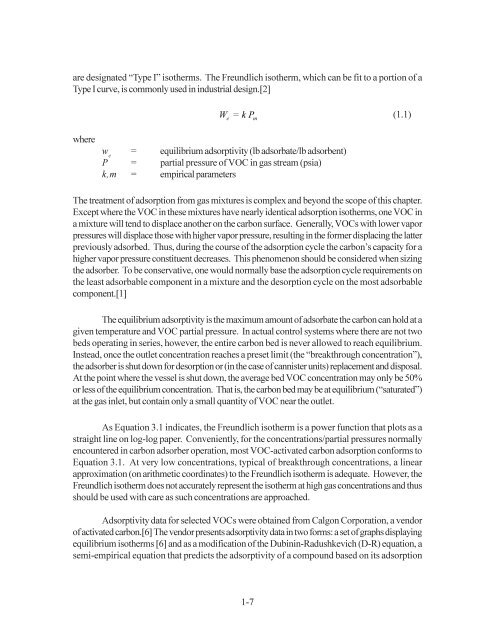Section 3 VOC Controls - US Environmental Protection Agency
Section 3 VOC Controls - US Environmental Protection Agency
Section 3 VOC Controls - US Environmental Protection Agency
Create successful ePaper yourself
Turn your PDF publications into a flip-book with our unique Google optimized e-Paper software.
are designated “Type I” isotherms. The Freundlich isotherm, which can be fit to a portion of a<br />
Type I curve, is commonly used in industrial design.[2]<br />
where<br />
W = k P<br />
e m (1.1)<br />
w e = equilibrium adsorptivity (lb adsorbate/lb adsorbent)<br />
P = partial pressure of <strong>VOC</strong> in gas stream (psia)<br />
k,m = empirical parameters<br />
The treatment of adsorption from gas mixtures is complex and beyond the scope of this chapter.<br />
Except where the <strong>VOC</strong> in these mixtures have nearly identical adsorption isotherms, one <strong>VOC</strong> in<br />
a mixture will tend to displace another on the carbon surface. Generally, <strong>VOC</strong>s with lower vapor<br />
pressures will displace those with higher vapor pressure, resulting in the former displacing the latter<br />
previously adsorbed. Thus, during the course of the adsorption cycle the carbon’s capacity for a<br />
higher vapor pressure constituent decreases. This phenomenon should be considered when sizing<br />
the adsorber. To be conservative, one would normally base the adsorption cycle requirements on<br />
the least adsorbable component in a mixture and the desorption cycle on the most adsorbable<br />
component.[1]<br />
The equilibrium adsorptivity is the maximum amount of adsorbate the carbon can hold at a<br />
given temperature and <strong>VOC</strong> partial pressure. In actual control systems where there are not two<br />
beds operating in series, however, the entire carbon bed is never allowed to reach equilibrium.<br />
Instead, once the outlet concentration reaches a preset limit (the “breakthrough concentration”),<br />
the adsorber is shut down for desorption or (in the case of cannister units) replacement and disposal.<br />
At the point where the vessel is shut down, the average bed <strong>VOC</strong> concentration may only be 50%<br />
or less of the equilibrium concentration. That is, the carbon bed may be at equilibrium (“saturated”)<br />
at the gas inlet, but contain only a small quantity of <strong>VOC</strong> near the outlet.<br />
As Equation 3.1 indicates, the Freundlich isotherm is a power function that plots as a<br />
straight line on log-log paper. Conveniently, for the concentrations/partial pressures normally<br />
encountered in carbon adsorber operation, most <strong>VOC</strong>-activated carbon adsorption conforms to<br />
Equation 3.1. At very low concentrations, typical of breakthrough concentrations, a linear<br />
approximation (on arithmetic coordinates) to the Freundlich isotherm is adequate. However, the<br />
Freundlich isotherm does not accurately represent the isotherm at high gas concentrations and thus<br />
should be used with care as such concentrations are approached.<br />
Adsorptivity data for selected <strong>VOC</strong>s were obtained from Calgon Corporation, a vendor<br />
of activated carbon.[6] The vendor presents adsorptivity data in two forms: a set of graphs displaying<br />
equilibrium isotherms [6] and as a modification of the Dubinin-Radushkevich (D-R) equation, a<br />
semi-empirical equation that predicts the adsorptivity of a compound based on its adsorption<br />
1-7

















